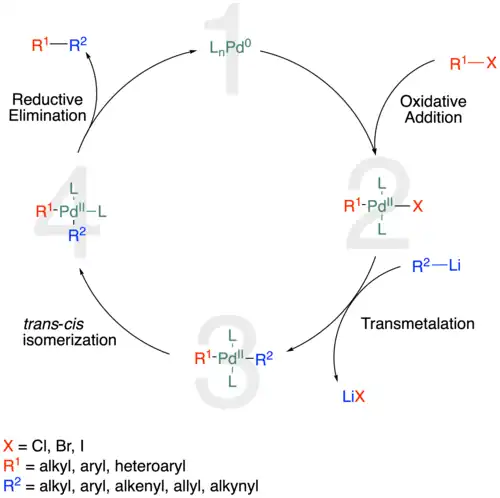| Murahashi Coupling | |
|---|---|
| Named after | Shun-Ichi Murahashi |
| Reaction type | Coupling reaction |
The Murahashi Coupling is a cross coupling reaction. The coupling partners are organolithiums and organic halides. Transition metal catalysts are required.[1] The reaction was first reported by Shun-Ichi Murahashi in 1974.[2] This reaction is notable for using organolithiums as opposed to other cross-coupling reactions which utilize various metal-carbon compounds (metal = tin, magnesium, boron, silicon, zinc). Since the production of these other coupling reagents relies heavily upon organolithiums (especially in the case of organozinc and organomagnesium compounds), in bypassing these intermediates, this process is much more efficient. It has further been shown that the Murahashi reaction proceeds with greater selectivity, faster reaction times, and lower reaction temperatures than other similar coupling reactions while maintaining similar or higher yields.[3][4][5]

History
Murahashi first reported C(sp2)—C(sp3) coupling in 1974. These reactions were not metal catalyzed but were promoted by solvent, THF. The following year, Murahashi showed that coupling can occur between organolithium and alkenyl halides in the presence of tetrakis(triphenylphosphine)palladium catalyst. In 1979, Murahashi published the catalytic version of this reaction.[6]
Mechanism
Palladium catalysis
The catalytic cycle of the Murahashi coupling is comparable to that of other extensively studied palladium-catalyzed cross-coupling reactions. The cycle proposed by Murahashi involves four intermediates and two oxidation states of palladium, palladium(0) and palladium(II). At the start of the cycle, oxidative addition occurs between the Pd(0) catalyst (1) and an organo-halide to form an organo-Pd(II) complex (2). A transmetallation then occurs between (2) and an organo-lithium to yield the trans-hetero-organometallic complex (3) and the lithium-halide. In order to perform the reductive elimination that ultimately yields the final coupled product, a trans-cis-isomerization of (3) must occur to bring the ligands cis to each other, resulting in the cis-hetero-organometallic complex (4). Finally, reductive elimination of (4) regenerates the Pd(0) catalyst and creates the C(sp2)--C(sp3) bond in the coupled product.[2]

Conditions limitations
Organolithium reagents pose some danger because they are highly pyrophoric.[7] The reaction is typically carried out in toluene as a solvent . The mixture is often carried out between 0–80 °C and quenched with acid to deactivate any remaining organolithium.[6]
Ruthenium catalysis
While Pd(0)-catalyzed reactions are highly efficient for the cross-coupling of organo-halides and organolithium reagents, ruthenium catalysts have also been demonstrated.[2]

See also
Citations
- ↑ Giannerini, M.; Fañanás-Mastral, M.; Feringa, B. L. Direct Catalytic Cross-Coupling of Organolithium Compounds. Nature Chem 2013, 5 (8), 667–672. https://doi.org/10.1038/nchem.1678.
- 1 2 3 Murahashi, S.; Yamamura, M.; Yanagisawa, K.; Mita, N.; Kondo, K. Stereoselective Synthesis of Alkenes and Alkenyl Sulfides from Alkenyl Halides Using Palladium and Ruthenium Catalysts. J. Org. Chem. 1979, 44 (14), 2408–2417. https://doi.org/10.1021/jo01328a016.
- ↑ Hornillos, V.; Giannerini, M.; Vila, C.; Fañanás-Mastral, M.; Feringa, B. L. Catalytic Direct Cross-Coupling of Organolithium Compounds with Aryl Chlorides. Org. Lett. 2013, 15 (19), 5114–5117. https://doi.org/10.1021/ol402408v.
- ↑ Heijnen, D.; Hornillos, V.; Corbet, B. P.; Giannerini, M.; Feringa, B. L. Palladium-Catalyzed C(Sp3)–C(Sp2) Cross-Coupling of (Trimethylsilyl)Methyllithium with (Hetero)Aryl Halides. Org. Lett. 2015, 17 (9), 2262–2265. https://doi.org/10.1021/acs.orglett.5b00905.
- ↑ Mateos-Gil, J.; Mondal, A.; Castiñeira Reis, M.; Feringa, B. L. Synthesis and Functionalization of Allenes by Direct Pd-Catalyzed Organolithium Cross-Coupling. Angewandte Chemie International Edition 2020, 59 (20), 7823–7829. https://doi.org/10.1002/anie.201913132.
- 1 2 Hazra, Susanta; Johansson Seechurn, Carin C. C.; Handa, Sachin; Colacot, Thomas J. (2021). "The Resurrection of Murahashi Coupling after Four Decades". ACS Catalysis. 11 (21): 13188–13202. doi:10.1021/acscatal.1c03564. S2CID 244613990.
- ↑ Schwindeman, J. A.; Woltermann, C. J.; Letchford, R. J. Safe Handling of Organolithium Compounds in the Laboratory. Chem. Health Saf. 2002, 9 (3), 6–11. https://doi.org/10.1016/S1074-9098(02)00295-2.